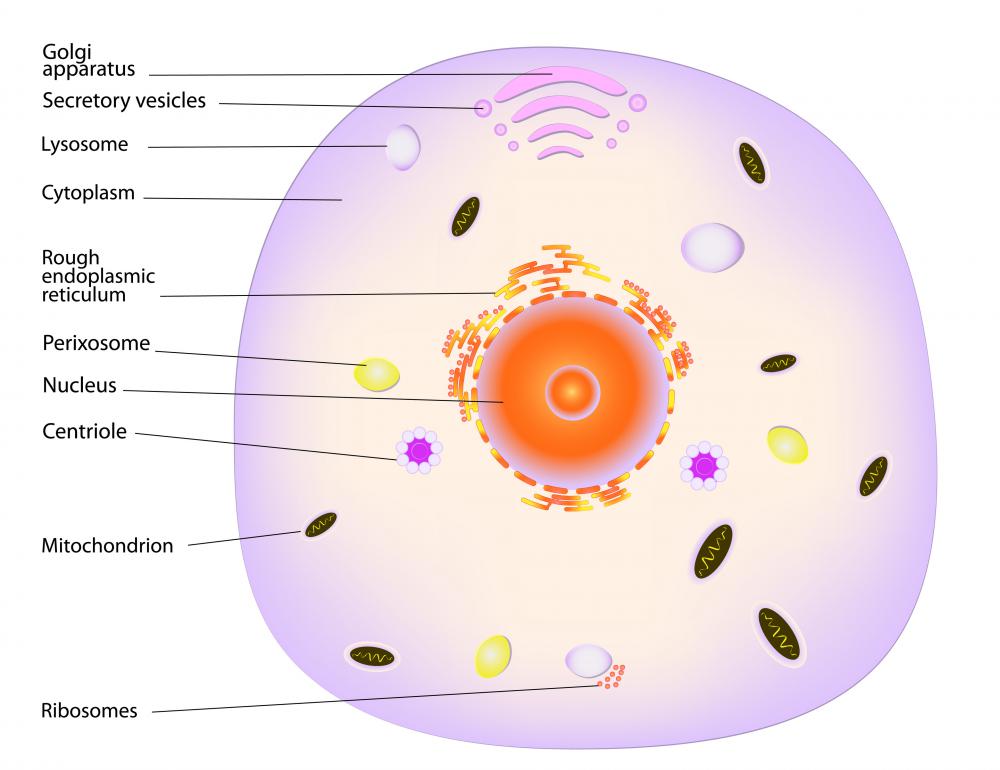At WiseGEEK, we're committed to delivering accurate, trustworthy information. Our expert-authored content is rigorously fact-checked and sourced from credible authorities. Discover how we uphold the highest standards in providing you with reliable knowledge.
What is the Function of Mitochondria?
Mitochondria are the cell powerhouse of eukaryotic cells. The main function of mitochondria is the production of adenosine triphosphate (ATP) via a process known as oxidative phosphorylation. ATP is a nucleotide that stores energy in the form of chemical bonds. Energy is derived from cell nutrients, mostly from glucose and fatty acids, and released whenever it is needed by the energy-requiring functions of cells. These energy-requiring cellular functions are membrane transport, synthesis of compounds for driving metabolic reactions, and mechanical work.
These structures are double membrane-bound cytoplasmic organelles found in most eukaryotic cells. They are flexible and rod shaped, and their diameter ranges from 0.5 to 1.0 micrometer. The membrane system of a mitochondrion consists of a smooth outer mitochondrial membrane and a folded inner mitochondrial membrane, separated by a narrow space called the intermembrane space. Matrix space, or intercristal space, is the large space enclosed by the inner membrane. Each of these components plays significant roles in cellular function and contribute to the main function of mitochondria.

The outer mitochondrial membrane has a large number of porins, which are transmembrane protein channels that permit the free diffusion of large and small molecules. It can allow molecules that are as large as 10 kilodaltons and as small as 6,000 daltons. This membrane is relatively permeable to ions and small molecules, thus the contents of the intermembrane space resemble the cytosol.

Nevertheless, the major function of mitochondria is found in the inner mitochondrial membrane and the matrix space. The inner mitochondrial membrane is folded into cristae, which provide a larger surface area for synthesis of ATP. This membrane possesses a large number of cardiolipins, which are phospholipids that make the latter nearly impermeable to protons, electrons, and ions. ATP synthase and respiratory chains, both protein complexes, are also found in this membrane. The ATP synthase is responsible for ATP generation, whereas the respiratory chains maintain the proton gradient that provides energy for oxidative phosphorylation.
The matrix space is filled with a dense fluid mostly composed of enzymes responsible for the degradation of fatty acids and pyruvate into the metabolic intermediate acetyl coenzyme A, and subsequent oxidation of this intermediate in the Krebs or tricarboxylic acid cycle. Pyruvate is an initial product of glucose metabolism that occurs in the cytosol, which is then transported into the mitochondria. The matrix space also contains the mitochondrial genetic system, the double-stranded mitochondrial circular deoxyribonucleic acid (cDNA) and the enzymes necessary for mitochondrial genome expression. Although it has its own genetic system, the necessary gene-encoded proteins needed for the formation and function of mitochondria to be normal are located in the genome of the cell’s nucleus.
AS FEATURED ON:
AS FEATURED ON:












Discussion Comments
@croydon - Regardless of how they evolved, the thing I find most interesting about mitochondria is that they can be traced back through the mother's line. They do reproduce, of course, and can change over time, but infants only receive their mitrochondria from the egg and not the sperm, so they don't have any from their father.
This makes it much easier to trace genealogy and trace populations, as it doesn't evolve nearly as quickly as cellular DNA.
@umbra21 - If that's true it must have happened a long time ago, as mitochondria are common to all eukaryotes, which means basically all plants and animals, and just about everything apart from bacteria.
I've also heard the theory that they appeared when eukaryotes first split from prokaryotic cells and are remnants of their own ancestral form that didn't change as much as the rest of the cell did. This would go some way to explaining why they seem more like bacteria, but I'm not sure this theory is considered as strong as the one you mentioned in the scientific community.
I've always loved the theory that mitochondria were once independent organisms that evolved to form a symbiotic relationship with eukaryotic cells. The function of mitochondria is basically to provide energy for our cells and our cells provide them with safety and other benefits, which is fairly similar to many other symbiotic relationships.
Plus mitochondria have their own DNA and are supposedly more similar to bacteria than not, so it isn't exactly a far fetched theory that they were once an infection that ended up being a blessing in disguise.
Post your comments